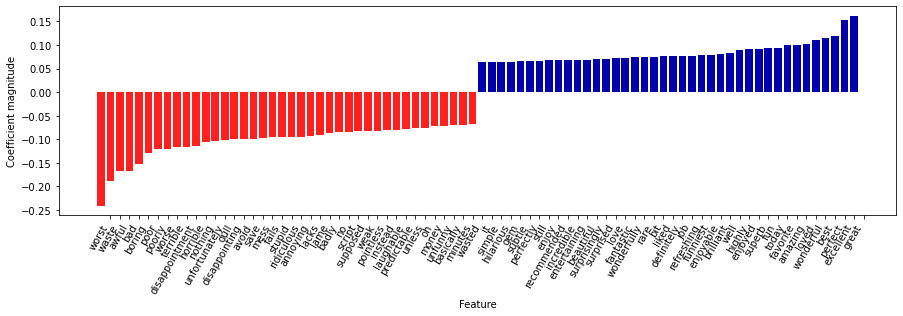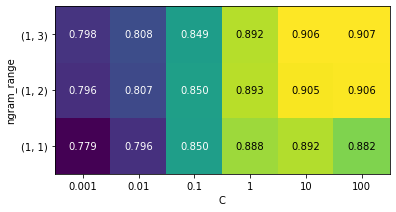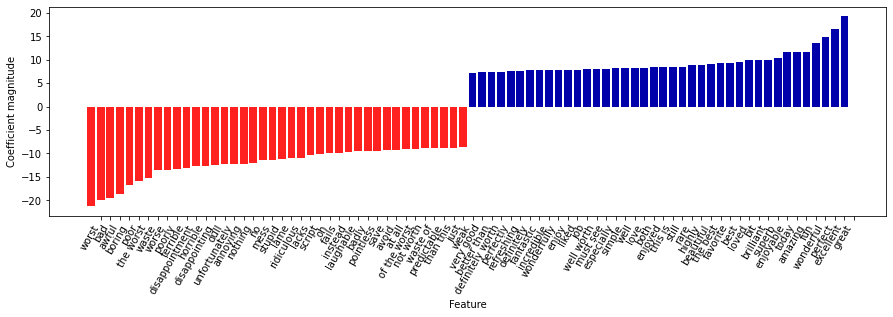处理文本数据(下):
4、停用词
删除没有信息量的单词还有另一种方法,就是舍弃那些出现次数太多以至于没有信息量的单词。有两种主要方法:使用特定语言的停用词(stopword)列表,或者舍弃那些出现过于频繁的单词。
- scikit-learn 的 feature_extraction.text 模块中提供了英语停用词的内置列表:
from sklearn.feature_extraction.text import ENGLISH_STOP_WORDS
print("Number of stop words: {}".format(len(ENGLISH_STOP_WORDS)))
print("Every 10th stopword:\n{}".format(list(ENGLISH_STOP_WORDS)[::10]))
# 指定 stop_words="english" 将使用内置列表
# 我们也可以扩展这个列表并传入我们自己的列表
vect = CountVectorizer(min_df=5, stop_words="english").fit(text_train)
X_train = vect.transform(text_train)
param_grid = {'C': [0.001, 0.01, 0.1, 1, 10]}
print("X_train with stop words:\n{}".format(repr(X_train)))
'''
<25000x26966 sparse matrix of type '<class 'numpy.int64'>'
with 2149958 stored elements in Compressed Sparse Row format>
'''
#现在数据集中的特征数量减少了 305 个(27271-26966),说明大部分停用词(但不是所有)都出现了。我们再次运行网格搜索:
grid = GridSearchCV(LogisticRegression(), param_grid, cv=5)
grid.fit(X_train, y_train)
print("Best cross-val上idation score: {:.2f}".format(grid.best_score_))
# Best cross-validation score: 0.88
5、用 tf-idf 缩放数据
另一种方法是按照我们预计的特征信息量大小来缩放特征,而不是舍弃那些认为不重要的特征。
最常见的一种做法就是使用词频 - 逆向文档频率(term frequency–inverse document frequency,tf-idf)方法。
这一方法对在某个特定文档中经常出现的术语给予很高的权重,但对在语料库的许多文档中都经常出现的术语给予的权重却不高。
如果一个单词在某个特定文档中经常出现,但在许多文档中却不常出现,那么这个单词很可能是对文档内容的很好描述。
scikit-learn 在两个类中实现了 tf-idf 方法:TfidfTransformer 和 TfidfVectorizer,前者接受 CountVectorizer 生成的稀疏矩阵并将其变换,后者接受文本数据并完成词袋特征提取与 tf-idf 变换。
由于 tf-idf 实际上利用了训练数据的统计学属性,所以我们将使用管 道,以确保网格搜索的结果有效。这样会得到下列代码:
from sklearn.feature_extraction.text import TfidfVectorizer
from sklearn.pipeline import make_pipeline
pipe = make_pipeline(TfidfVectorizer(min_df=5, norm=None),
LogisticRegression())
param_grid = {'logisticregression__C': [0.001, 0.01, 0.1, 1, 10]}
grid = GridSearchCV(pipe, param_grid, cv=5)
grid.fit(text_train, y_train)
print("Best cross-validation score: {:.2f}".format(grid.best_score_))
# Best cross-validation score: 0.89
如你所见,使用 tf-idf 代替仅统计词数对性能有所提高。我们还可以查看 tf-idf 找到的最重要的单词。请记住,tf-idf 缩放的目的是找到能够区分文档的单词,但它完全是一种无监督技术。
因此,这里的 “重要” 不一定与我们感兴趣的 “正面评论” 和 “负面评论” 标签相关。
首先,我们从管道中提取 TfidfVectorizer:
vectorizer = grid.best_estimator_.named_steps["tfidfvectorizer"]
# 变换训练数据集
X_train = vectorizer.transform(text_train)
# 找到数据集中每个特征的最大值
max_value = X_train.max(axis=0).toarray().ravel()
sorted_by_tfidf = max_value.argsort()
# 获取特征名称
feature_names = np.array(vectorizer.get_feature_names())
print("Features with lowest tfidf:\n{}".format(feature_names[sorted_by_tfidf[:20]]))
'''
Features with lowest tfidf:
['poignant' 'disagree' 'instantly' 'importantly' 'lacked' 'occurred'
'currently' 'altogether' 'nearby' 'undoubtedly' 'directs' 'fond' 'stinker'
'avoided' 'emphasis' 'commented' 'disappoint' 'realizing' 'downhill'
'inane']
'''
print("Features with highest tfidf: \n{}".format(feature_names[sorted_by_tfidf[-20:]]))
'''
Features with highest tfidf:
['coop' 'homer' 'dillinger' 'hackenstein' 'gadget' 'taker' 'macarthur'
'vargas' 'jesse' 'basket' 'dominick' 'the' 'victor' 'bridget' 'victoria'
'khouri' 'zizek' 'rob' 'timon' 'titanic']
'''
tf-idf 较小的特征要么是在许多文档里都很常用,要么就是很少使用,且仅出现在非常长的文档中。
有趣的是,许多 tf-idf 较大的特征实际上对应的是特定的演出或电影。这些术语仅出现在这些特定演出或电影的评论中,但往往在这些评论中多次出现。例如,对于 “pokemon”、“smallville” 和 “doodlebops” 是显而易见的,但这里的 “scanners” 实际上指的也是电影标题。
这些单词不太可能有助于我们的情感分类任务(除非有些电影的评价可 能普遍偏正面或偏负面),但肯定包含了关于评论的大量具体信息。
6、研究模型系数
最后,我们详细看一下 Logistic 回归模型从数据中实际学到的内容。由于特征数量非常多 (删除出现次数不多的特征之后还有 27 271 个),所以显然我们不能同时查看所有系数。但 是,我们可以查看最大的系数,并查看这些系数对应的单词。我们将使用基于 tf-idf 特征训练的最后一个模型。
下面这张条形图给出了 Logistic 回归模型中最大的 25 个系数与最小的 25 个系数,其高度表示每个系数的大小:
import mglearn
mglearn.tools.visualize_coefficients(
grid.best_estimator_.named_steps["logisticregression"].coef_,
feature_names, n_top_features=40)

左侧的负系数属于模型找到的表示负面评论的单词,而右侧的正系数属于模型找到的表示正面评论的单词。
大多数单词都是非常直观的,比如 “worst”(最差)、“waste”(浪费)、“disappointment”(失望)和 “laughable”(可笑)都表示不好的电影评论,而 “excellent”(优秀)、“wonderful”(精彩)、“enjoyable”(令人愉悦)和 “refreshing” (耳目一新)则表示正面的电影评论。
有些词的含义不那么明确,比如 “bit”(一点)、 “job”(工作)和 “today”(今天),但它们可能是类似 “good job”(做得不错)和 “best today”(今日最佳)等短语的一部分。
7、多个单词的词袋(n 元分组)
使用词袋表示的主要缺点之一是完全舍弃了单词顺序。
因此,“it’s bad, not good at all”(电影很差,一点也不好)和 “it’s good, not bad at all”(电影很好,还不错)这两个字符串的词袋表示完全相同,尽管它们的含义相反。
将 “not”(不)放在单词前面,这只是上下文很重要的一个例子(可能是一个极端的例子)。
幸运的是,使用词袋表示时有一种获取上下文的方法,就是不仅考虑单一词例的计数,而且还考虑相邻的两个或三个词例的计数。
两个词例被称为二元分词(bigram),三个词例被称为三元分词(trigram),更一般的词例序列被称为 n 元分词(n-gram)。
我们可以通过改变 CountVectorizer 或 TfidfVectorizer 的 ngram_range 参数来改变作为特征的词例范围。
#我们在 IMDb 电影评论数据上尝试使用 TfidfVectorizer,并利用网格搜索找出 n 元分词的最佳设置:
pipe = make_pipeline(TfidfVectorizer(min_df=5), LogisticRegression())
# 运行网格搜索需要很长的时间,因为网格相对较大,且包含三元分组
param_grid = {'logisticregression__C': [0.001, 0.01, 0.1, 1, 10, 100],
"tfidfvectorizer__ngram_range": [(1, 1), (1, 2), (1, 3)]}
grid = GridSearchCV(pipe, param_grid, cv=5)
grid.fit(text_train, y_train)
print("Best cross-validation score: {:.2f}".format(grid.best_score_))
# Best cross-validation score: 0.91
print("Best parameters:\n{}".format(grid.best_params_))
'''
Best parameters:
{'logisticregression__C': 100, 'tfidfvectorizer__ngram_range': (1, 3)}
'''
#将交叉验证精度作为 ngram_range 和 C 参数的函数并用热图可视化:
# 从网格搜索中提取分数
scores = grid.cv_results_['mean_test_score'].reshape(-1, 3).T
# 热图可视化
heatmap = mglearn.tools.heatmap(
scores, xlabel="C", ylabel="ngram_range", cmap="viridis", fmt="%.3f",
xticklabels=param_grid['logisticregression__C'],
yticklabels=param_grid['tfidfvectorizer__ngram_range'])
plt.colorbar(heatmap)

从热图中可以看出,使用二元分词对性能有很大提高,而添加三元分词对精度只有很小贡献。
为了更好地理解模型是如何改进的,我们可以将最佳模型的重要系数可视化,其中包含一元分词、二元分词和三元分词:

8、主题建模与文档聚类
常用于文本数据的一种特殊技术是主题建模(topic modeling),这是描述将每个文档分配给一个或多个主题的任务(通常是无监督的)的概括性术语。这方面一个很好的例子是新闻数据,它们可以被分为 “政治” “体育” “金融” 等主题。
8.1、隐含狄利克雷分布
LDA 模型试图找出频繁共同出现的单词群组(即主题)。LDA 还要求,每个文档可以被理解为主题子集的 “混合”。重要的是要理解,机器学习模型所谓的 “主题” 可能不是我们通常在日常对话中所说的主题,而是更类似于 PCA 或 NMF所提取的成分,它可能具有语义,也可能没有。
我们将 LDA 应用于电影评论数据集,来看一下它在实践中的效果。对于无监督的文本文档模型,通常最好删除非常常见的单词,否则它们可能会支配分析过程。我们将删除至少在 15% 的文档中出现过的单词,并在删除前 15% 之后,将词袋模型限定为最常见的 10 000 个单词:
vect = CountVectorizer(max_features=10000, max_df=.15)
X = vect.fit_transform(text_train)
from sklearn.decomposition import LatentDirichletAllocation
lda = LatentDirichletAllocation(n_topics=10, learning_method="batch",
max_iter=25, random_state=0)
#我们在一个步骤中构建模型并变换数据
#计算变换需要花点时间,二者同时进行可以节省时间
document_topics = lda.fit_transform(X)
print("lda.components_.shape: {}".format(lda.components_.shape))
'''
lda.components_.shape: (10, 10000)
'''
#对于每个主题(components_的一行),将特征排序(升序)
#用[:, ::-1]将行反转,使排序变为降序
sorting = np.argsort(lda.components_, axis=1)[:, ::-1]
#从向量器中获取特征名称
feature_names = np.array(vect.get_feature_names())
#打印出前10个主题:
mglearn.tools.print_topics(topics=range(10), feature_names=feature_names,
sorting=sorting, topics_per_chunk=5, n_words=10)
'''
'''
topic 0 topic 1 topic 2 topic 3 topic 4
-------- -------- -------- -------- --------
between war funny show didn
family world comedy series saw
young us guy episode thought
real american laugh tv am
us our jokes episodes thing
director documentary fun shows got
work history humor season 10
both years re new want
beautiful new hilarious years going
each human doesn television watched
topic 5 topic 6 topic 7 topic 8 topic 9
-------- -------- -------- -------- --------
action kids role performance horror
effects action cast role house
nothing animation john john killer
budget children version actor gets
script game novel cast woman
minutes disney director plays dead
original fun both jack girl
director old played michael around
least 10 mr oscar goes
doesn kid young father wife
'''
'''
lda100 = LatentDirichletAllocation(n_topics=100, learning_method="batch",
max_iter=25, random_state=0)
document_topics100 = lda100.fit_transform(X)
#查看所有 100 个主题可能有点困难,所以我们选取了一些有趣的而且有代表性的主题:
topics = np.array([7, 16, 24, 25, 28, 36, 37, 41, 45, 51, 53, 54, 63, 89, 97])
sorting = np.argsort(lda100.components_, axis=1)[:, ::-1]
feature_names = np.array(vect.get_feature_names())
mglearn.tools.print_topics(topics=topics, feature_names=feature_names,
sorting=sorting, topics_per_chunk=5, n_words=20)
'''
'''
topic 7 topic 16 topic 24 topic 25 topic 28
-------- -------- -------- -------- --------
thriller worst german car beautiful
suspense awful hitler gets young
horror boring nazi guy old
atmosphere horrible midnight around romantic
mystery stupid joe down between
house thing germany kill romance
director terrible years goes wonderful
quite script history killed heart
bit nothing new going feel
de worse modesty house year
performances waste cowboy away each
dark pretty jewish head french
twist minutes past take sweet
hitchcock didn kirk another boy
tension actors young getting loved
interesting actually spanish doesn girl
mysterious re enterprise now relationship
murder supposed von night saw
ending mean nazis right both
creepy want spock woman simple
topic 36 topic 37 topic 41 topic 45 topic 51
-------- -------- -------- -------- --------
performance excellent war music earth
role highly american song space
actor amazing world songs planet
cast wonderful soldiers rock superman
play truly military band alien
actors superb army soundtrack world
performances actors tarzan singing evil
played brilliant soldier voice humans
supporting recommend america singer aliens
director quite country sing human
oscar performance americans musical creatures
roles performances during roll miike
actress perfect men fan monsters
excellent drama us metal apes
screen without government concert clark
plays beautiful jungle playing burton
award human vietnam hear tim
work moving ii fans outer
playing world political prince men
gives recommended against especially moon
topic 53 topic 54 topic 63 topic 89 topic 97
-------- -------- -------- -------- --------
scott money funny dead didn
gary budget comedy zombie thought
streisand actors laugh gore wasn
star low jokes zombies ending
hart worst humor blood minutes
lundgren waste hilarious horror got
dolph 10 laughs flesh felt
career give fun minutes part
sabrina want re body going
role nothing funniest living seemed
temple terrible laughing eating bit
phantom crap joke flick found
judy must few budget though
melissa reviews moments head nothing
zorro imdb guy gory lot
gets director unfunny evil saw
barbra thing times shot long
cast believe laughed low interesting
short am comedies fulci few
serial actually isn re half
'''
'''
在没有标签的情况下(或者像本章的例子这样,即使有标签的情况下),像 LDA 这样的主 题模型是理解大型文本语料库的有趣方法。不过 LDA 算法是随机的,改变 random_state 参数可能会得到完全不同的结果。虽然找到主题可能很有用,但对于从无监督模型中得出的任何结论都应该持保留态度,我们建议通过查看特定主题中的文档来验证你的直觉。 LDA.transform 方法生成的主题有时也可以用于监督学习的紧凑表示。当训练样例很少时, 这一方法特别有用。
参考文献
《机器学习基础教程》



【推荐】国内首个AI IDE,深度理解中文开发场景,立即下载体验Trae
【推荐】编程新体验,更懂你的AI,立即体验豆包MarsCode编程助手
【推荐】抖音旗下AI助手豆包,你的智能百科全书,全免费不限次数
【推荐】轻量又高性能的 SSH 工具 IShell:AI 加持,快人一步
· 25岁的心里话
· 闲置电脑爆改个人服务器(超详细) #公网映射 #Vmware虚拟网络编辑器
· 零经验选手,Compose 一天开发一款小游戏!
· 因为Apifox不支持离线,我果断选择了Apipost!
· 通过 API 将Deepseek响应流式内容输出到前端